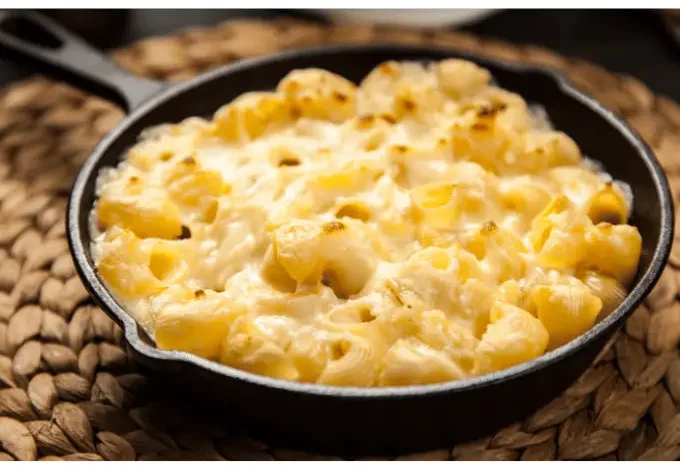REAL ITALIAN MAC AND CHEESE

Welcome to the world of REAL Italian Mac and Cheese. We’ll dive into the authentic flavors, ingredients, and techniques that make this dish a true Italian classic. Prepare to tantalize your taste buds with rich cheeses, aromatic herbs, and perfectly cooked pasta. Let’s uncover the secrets to crafting the perfect Italian Mac and Cheese that will beg your friends and family for more.
Choosing the Best Cheese for Authentic Flavor
The right cheeses are crucial when creating an authentic Italian Mac and Cheese. Here are some essential cheeses to consider for that unmistakable Italian taste:
- Parmigiano-Reggiano: Known as the “King of Cheeses,” Parmigiano-Reggiano brings a nutty, savory flavor to your mac and cheese. Look for authentic Parmigiano-Reggiano from Italy for the best taste.
- Pecorino Romano: Made from sheep’s milk, Pecorino Romano adds a sharp, salty kick to your dish. It pairs perfectly with Parmigiano-Reggiano for a balanced flavor profile.
- Fontina: This creamy, semi-soft cheese hails from the Valle d’Aosta region of Italy. It melts beautifully and adds a rich buttery taste to your mac and cheese.
- Gruyère: While not traditionally Italian, Gruyère is often used in Italian-inspired mac and cheese recipes for its reliability and slightly sweet flavor.
- Mozzarella: Add fresh mozzarella to your mac and cheese for that gooey, stretchy texture. It adds a mild, milky flavor that complements the other cheeses well.
When selecting cheeses, select high-quality, authentic varieties for the best flavor. Experiment with different combinations to find the perfect balance of creaminess, tanginess, and richness for your Italian Mac and Cheese masterpiece.
Ingredient Notes and Substitutions for Traditional Taste
Attention to detail in ingredient selection is critical to truly capture the essence of Italian Mac and Cheese. Here’s a breakdown of the essential components and possible substitutions:
- Pasta: Choose short, sturdy pasta shapes like elbow macaroni, penne, or rigatoni. These shapes hold up well to the thick cheese sauce. You can substitute with whole wheat or gluten-free pasta to accommodate dietary preferences or restrictions.
- Cheeses: Parmigiano-Reggiano, Pecorino Romano, Fontina, Gruyère, and mozzarella are the show’s stars. However, if you cannot find one of these cheeses, you can substitute it with a similar variety that offers a similar flavor profile and melting capability. Just be mindful of maintaining the balance of flavors.
- Butter: Use unsalted butter for a clean, pure flavor. If you prefer, you can substitute with olive oil for a slightly different taste profile.
- Flour: All-purpose flour typically creates a roux, which thickens the cheese sauce. If you need a gluten-free option, use a gluten-free flour blend or cornstarch as a thickening agent.
- Milk: Whole milk is preferred for its richness, but you can use low-fat or plant-based alternatives such as almond or oat milk if desired.
- Seasonings: Freshly ground black pepper adds a nice kick to the dish. For extra flavor depth, you can also incorporate other Italian herbs and spices like garlic powder, onion powder, or dried oregano.
- Optional Additions: While traditional Italian Mac and Cheese typically focus on the cheese and pasta, you can customize your dish with additional ingredients such as cooked pancetta or bacon, sautéed mushrooms, caramelized onions, or chopped fresh herbs like parsley or basil. Just be mindful not to overpower the delicate cheese flavors.
By paying attention to these ingredient notes and substitutions, you can ensure that your Italian Mac and Cheese stays true to its authentic roots while accommodating dietary preferences or restrictions.
Step-by-Step Directions for Crafting Authentic Mac and Cheese
Follow these detailed instructions to create a mouthwatering batch of REAL Italian Mac and Cheese:
Step 1: Cook the Pasta
- Bring a large pot of salted water to a boil.
- Add the pasta and cook according to package instructions until al dente.
- Drain the pasta, reserving about 1 cup of the cooking water. Set aside.
Step 2: Prepare the Cheese Sauce
- In a large saucepan, melt the butter over medium heat.
- Once melted, whisk in the flour to create a roux. Cook for 1-2 minutes, constantly stirring, until the roux is golden brown and fragrant.
- Gradually pour in the milk, whisking constantly to prevent lumps from forming.
- Cook the sauce, stirring frequently, until it thickens enough to coat the back of a spoon, about 5-7 minutes.
- Reduce the heat to low and add the grated cheeses, reserving a small portion for topping if desired. Stir until the cheeses are melted and the sauce is smooth and creamy. If the sauce is too thick, you can gradually add some of the reserved pasta cooking water to thin it out to your desired consistency.
Step 3: Combine the Pasta and Sauce
- Add the cooked pasta to the cheese sauce, stirring gently to coat the pasta evenly with the sauce.
- If you add optional ingredients like cooked pancetta or sautéed mushrooms, incorporate them into the mixture.
Step 4: Bake (Optional)
- Transfer the mixture to a baking dish if you prefer a baked crust on your mac and cheese.
- Sprinkle the reserved grated cheese on top of the pasta.
- Bake in a preheated oven at 350°F (175°C) for 20-25 minutes or until the cheese is bubbly and golden brown on top.
Step 5: Serve and Enjoy
- Once baked (if applicable) or immediately after combining the pasta and sauce, serve your Italian Mac and Cheese hot.
- Garnish with freshly ground black pepper and chopped herbs if desired.
- Enjoy the creamy, cheesy goodness of this authentic Italian comfort food!
Following these step-by-step directions, you can create a delicious batch of REAL Italian Mac and Cheese that will impress your family and friends.
Pro Tips for Perfecting Your Italian Mac and Cheese
Achieving the perfect balance of flavours and textures in your Italian Mac and Cheese requires attention to detail. Here are some pro tips to help you elevate your dish:
- Use a Combination of Cheeses: Experiment with different combinations of cheeses to create a complex flavour profile. Mixing Parmigiano-Reggiano with Pecorino Romano and Fontina, for example, adds depth and richness to your sauce.
- Grate Your Cheese: For the best flavour and texture, grate your cheese fresh from the block rather than using pre-shredded cheese, which often contains anti-caking agents that can affect the reliability of the cheese.
- Don’t Overcook the Pasta: Cook the pasta until al dente, as it will continue to cook when combined with the hot cheese sauce. Overcooking can result in mushy pasta.
- Save Pasta Water: Reserve some cooking water before draining the cooked pasta. The starchy water can thin out the cheese sauce if it becomes too thick, helping to maintain a creamy consistency.
- Season Thoughtfully: Taste the cheese sauce before combining it with the pasta. Adjust the seasoning with salt, pepper, and herbs or spices to ensure a well-balanced flavour.
- Customize with Add-Ins: While the base recipe for Italian Mac and Cheese is delicious, feel free to get creative with add-ins. Add cooked pancetta, caramelized onions, roasted garlic, or sautéed mushrooms for extra flavour depth.
- Garnish Wisely: Finish your mac and cheese with freshly ground black pepper and chopped herbs like parsley or basil for freshness and colour.
- Serve Immediately: Italian Mac and Cheese is best hot and fresh. Serve it immediately after preparing it to preserve the creamy texture and gooey cheese goodness.
By incorporating these pro tips into your cooking process, you’ll be well on your way to perfecting your Italian Mac and Cheese and delighting your taste buds with each indulgent bite.
Frequently Asked Questions Answered
Here are answers to some common questions about Italian Mac and Cheese:
Can I make Italian Mac and Cheese ahead of time?
- While best enjoyed fresh, prepare the cheese sauce and cook the pasta beforehand. Store it separately in the refrigerator, then combine and bake (if desired) just before serving. Keep in mind that the texture may be slightly different when reheated.
How can I make my mac and cheese creamier?
- To achieve a creamier texture, try increasing the amount of milk in the cheese sauce or adding a splash of heavy cream. You can also incorporate a creamy cheese like mascarpone or cream cheese into the sauce for extra richness.
Can I freeze Italian Mac and Cheese?
- While you can technically freeze mac and cheese, the texture may suffer upon thawing. The cheese sauce can become grainy, and the pasta may become mushy. If you freeze it, wrap it tightly and use it within 1-2 months for the best quality.
How do I reheat leftover mac and cheese?
- Reheat individual portions in the microwave or reheat larger quantities in a baking dish in the oven. Cover the dish with foil to prevent drying out, and add a splash of milk or cream to help revive the creaminess.
Can I make Italian Mac and Cheese without using a roux?
- While a roux helps to thicken the cheese sauce and provides a silky texture, you can make a simpler version of mac and cheese by skipping the roux and simply melting cheese into hot milk. Remember that the sauce may be thick and creamy with the roux.
How can I make my mac and cheese more flavorful?
- Experiment with different cheeses, herbs, and seasonings to enhance the flavor of your mac and cheese. You can also add delicious ingredients like caramelized onions, roasted garlic, or sun-dried tomatoes for extra depth of flavor.
Addressing these frequently asked questions will help you better understand how to prepare, store, and customize your Italian Mac and Cheese to suit your preferences and needs.
Pairing Suggestions: What to Serve with Your Mac and Cheese
Italian Mac and Cheese is a rich and indulgent dish that pairs well with various sides and accompaniments. Here are some delicious pairing suggestions to complement your mac and cheese:
- Green Salad: Balance out the richness of the mac and cheese with a crisp, refreshing green salad tossed with a light vinaigrette dressing. The acidity and crunch of the salad provide a nice contrast to the creamy pasta dish.
- Garlic Bread: Serve warm, crusty garlic bread on the side to soak up any leftover cheese sauce and add a garlicky, buttery flavour to each bite. It’s the perfect accompaniment for mopping up every last bit of sauce from your plate.
- Roasted Vegetables: Roasted vegetables like broccoli, cauliflower, or Brussels sprouts make a flavorful and nutritious side dish for mac and cheese. The caramelized edges and earthy flavours of the vegetables complement the creamy, cheesy pasta.
- Italian Antipasto Platter: Create a spread of Italian cured meats, cheeses, olives, and marinated vegetables for a rustic and satisfying accompaniment to your mac and cheese. The variety of flavours and textures will add depth to your meal.
- Crusty Bread and Dipping Oil: Serve slices of crusty Italian bread alongside a dish of extra virgin olive oil seasoned with herbs, garlic, and a sprinkle of Parmesan cheese for dipping. It’s a simple yet satisfying addition to your mac and cheese dinner.
- Tomato Soup: For a classic comfort food pairing, serve creamy tomato soup alongside your mac and cheese. The tangy acidity of the tomatoes and the creamy texture of the soup complement the richness of the pasta dish.
- Grilled Chicken or Sausage: Add protein to your meal by serving grilled chicken breast or Italian sausage alongside your mac and cheese. The savoury flavours of the meat pair well with the cheesy pasta and add a heartier element to the dish.
- Fruit Salad: Refresh your palate with a light, fruity salad with seasonal fruits like berries, melon, and citrus. The natural sweetness and juiciness of the fruit provide a delightful contrast to the savoury mac and cheese.
These pairing suggestions offer a range of flavours and textures to enhance your Italian Mac and Cheese experience and create a well-rounded meal that satisfies all your cravings. Experiment with different combinations to find your perfect match!
Recipe: REAL Italian Mac and Cheese
Here’s a step-by-step recipe for crafting an authentic and delicious batch of Italian Mac and Cheese:
Equipment
To make authentic Italian mac and cheese, you’ll need:
- Large Pot or Saucepan: For boiling pasta.
- Colander or Strainer: To drain the cooked pasta.
- Whisk or Wooden Spoon: To make the cheese sauce.
- Grater: To grate the cheese finely.
- Measuring Cups and Spoons: These are used to measure ingredients precisely.
- Ovenproof Baking Dish (Optional): If you want to bake the mac and cheese after assembling.
- Stovetop or Oven: To cook the pasta and melt the cheese sauce.
These essential kitchen tools are all you need to prepare authentic Italian mac and cheese.
Ingredients
- 12 ounces (340g) short pasta, such as elbow macaroni or penne
- 4 tablespoons (56g) unsalted butter
- 1/4 cup (30g) all-purpose flour
- 3 cups (720ml) whole milk
- 1 cup (100g) grated Parmigiano-Reggiano cheese
- 1 cup (100g) grated Pecorino Romano cheese
- 1 cup (120g) grated Fontina cheese
- 1 cup (120g) grated Gruyère cheese
- 1 cup (120g) shredded mozzarella cheese
- Salt and freshly ground black pepper to taste
- Optional: chopped fresh herbs, such as parsley or basil, for garnish
Instructions
Cook the Pasta
- Bring a large pot of salted water to a boil.
- Add the pasta and cook according to package instructions until al dente.
- Drain the pasta, reserving about 1 cup of the cooking water. Set aside.
Prepare the Cheese Sauce
- In a large saucepan, melt the butter over medium heat.
- Once melted, whisk in the flour to create a roux. Cook for 1-2 minutes, stirring constantly, until the roux is golden brown and fragrant.
- Gradually pour in the milk, whisking constantly to prevent lumps from forming.
- Cook the sauce, stirring frequently, until it thickens enough to coat the back of a spoon, about 5-7 minutes.
- Reduce the heat to low and add the grated cheeses, reserving a small portion for topping if desired. Stir until the cheeses are melted and the sauce is smooth and creamy. If the sauce is too thick, you can gradually add some of the reserved pasta cooking water to thin it out to your desired consistency.
Combine the Pasta and Sauce
- Add the cooked pasta to the cheese sauce, stirring gently to coat the pasta evenly with the sauce.
- If you add optional ingredients like cooked pancetta or sautéed mushrooms, incorporate them into the mixture.
Serve and Enjoy
- Once combined, serve your Italian Mac and Cheese hot.
- Garnish with freshly ground black pepper and chopped herbs if desired.
- Enjoy the creamy, cheesy goodness of this authentic Italian comfort food!
Feel free to customize this recipe by adjusting the types and amounts of cheese to suit your taste preferences. Whether served as a main dish or a side, this REAL Italian Mac and Cheese will surely be a hit with family and friends.
Conclusion
In conclusion, diving into REAL Italian Mac and Cheese offers a rich tapestry of culinary possibilities. With the perfect blend of cheeses and a mastery of basic techniques, you can transform simple ingredients into a comforting, gourmet dish that pleases casual diners and connoisseurs alike. Whether serving it as a standalone meal or alongside various accompaniments, this dish embodies the heart and soul of Italian cooking. Remember to explore variations and pairings to keep your meals exciting and flavorful.
MORE RECIPES
For more Italian recipes, now visit;




